Article from the Weekend Gardener Online Magazine
by Hilary Rinaldi, member of the National Garden Writers Association

Grow Bananas Indoors
Add a touch of the tropics to your home this winter
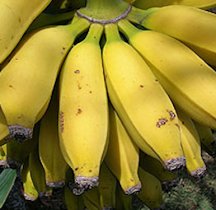 So
often during the cold winter months people get tired of growing the
same old "house plants" and want to try something more tropical,
exotic, or unusual. If you're one of
those people, a great plant to try is a dwarf banana plant because it's
fairly exotic, very tropical, and yet so simple to grow indoors. Bananas
truly bring a tropical feel to your home, because their foliage gets
lush and full, they supply fresh fruit, and they really look like
something straight out of Hawaii. In
addition to bringing a fresh look to your house, they do well with
minimum maintenance, are self-fruitful, so they don't need a
pollinator, and all banana varieties do well indoors. Basically, there
is no reason not to try a banana if you really want a fun project this
winter. I think after reading this
you'll be able to forget about the cold temperatures outdoors for a
little while, because once you see how easy it is to grow bananas
indoors, you'll be excited to bring something very summer-like into
your home right now..
Bananas An Overview
Bananas
(Musa spp.), are herbaceous perennials, almost like a giant herb, and
must be treated as such. Their "trunks" are not made of wood, but of
leaf bases wrapped tightly around each other to form a tube.
The
true stem begins as an underground corm which grows upwards, pushing
its way out through the center of the stalk which will later bear the
fruit. Each stalk produces one huge flower cluster and then dies. New
stalks then grow from the rhizome.
Since bananas multiply by
underground rhizomes, each new stalk will produce one large flower
cluster and fruit. The stalk on the new dwarf and super dwarf varieties
that are mentioned below, grow and produce fruit within 1 year.
The
larger banana varieties can take 9 months to grow and another four to
eight months for the fruit to mature. Fertilizers rich in potassium,
however, do help speed up the fruiting process.
The suckers, called "pups" that regularly come up from the base of the mother plant can be removed to start a new banana plant.
But
make sure that after a stalk has fruited, allow one replacement sucker
to grow in its place, because the main stalk will die after its fruit
has matured.
Bananas, like any tropical plant, need a
combination of warmth, bright light, and high humidity; conditions that
most homes already can provide. They will however, need these basic
requirements year-round, not just when it's warm and sunny outside.
|
Musa Dwarf Cavendish
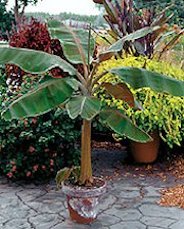
Banana fruit
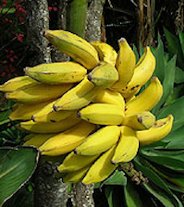
|
How To Grow Bananas Indoors
Buying Bananas:
Most
nurseries don't carry bananas but most will special order them for you,
or you can order them via direct mail catalog or on the internet.
There are several online tropical growers and even Amazon.com carries many vendors that sell bananas.
Mail
order bananas usually come in the form of a corm. After receiving the
corm, wash it in lukewarm water to remove any fungal or bacterial
growth, which may have developed during shipping.
Soil
The
first priority to consider when growing a banana is to use the proper
soil. It is very important to use a light, well draining soil mixture
that has lots of peat, perlite and vermiculite in the mix, and then to
make sure you have really good drainage, add 20 percent more perlite to
the mix.
Don't use heavy soils when growing bananas such as
heavy potting soil, or soil from a yard. Bananas like an acidic growing
mix with a pH between 5.5 and 6.5.
Planting:
Grow
bananas in a container that is not too large. It should be a standard 6
inch (15 cm) or 8 inch (20 cm) pot with a drainage hole. Never plant it
in a container without a drainage hole. You can always transplant to a
larger container when your plant is quite crowded.
The container
you choose should be fairly deep and broad to allow a minimum of 3
inches (7.5 cm) on both sides between the corm and the inside of the
container.
Plant the banana corm (rhizome) upright and be sure
the roots are well covered, but don't cover the corm entirely. The top
20 percent of the corm should remain exposed until the new plant has
produced several new leaves.
Remember this when potting, and
leave enough room to later cover the corm completely. Burying the corm
after a few leaves have been produced, promotes additional roots and
better stability.
Bananas will stop growing even if fed, when
they become even marginally pot bound, so you may need to transplant to
a larger container in time.
Growing & Maintenance Requirements:
Water
Bananas like lots of water because of their enormous leaves, but it is just as important not to overwater as to underwater.
As
with any houseplant, water when needed and keep the soil evenly moist.
To help with this, you can cover the soil with a layer of decorative
bark or other organic material to act as a mulch.
Allow the soil
to dry slightly between waterings, about when the soil is dry to a 1/2
inch (1.25 cm) in depth. Use your fingers to feel the soil. You'll be
able to tell quite easily.
NOTE:
Please do not expect this to be a plant that you "water once a week."
If you water once a week without allowing the plant to dry out a bit in
between waterings, it is unlikely that you will have success growing
this plant!
Fertilizer
Fertilize
at least once month, especially when the plant approaches maturity and
starts to produce fruit. If there are fewer than 10-12 leaves when the
plant gets ready to flower, the fruit will take longer to reach full
size and ripen. Insufficient leaves are usually a sign that the plant
needs more nitrogen and water.
If your plant is producing one
flower after another, it's doing really well, but it will need a
consistent supply of nutrients in the form of fertilizer to keep up
with its nutritional needs at this time.
TIP:
You can water and fertilize bananas at the same time using any type of
good balanced fertilizer, like a 5-5-5, or 10-10-10. It is possible to
over feed however, which causes the leaves to deform; therefore, if you
are going to feed with your water, use the fertilizer at half strength.
Light and Humidity
Bananas,
being tropical plants, like lots of bright, indirect light, so a good
southern exposure would be ideal. Provide maximum sunlight and warmth,
with 12 hours of bright light being ideal for most varieties.
If
the area where you want to place your banana is a bit on the dark side,
using a high-intensity light of 100 watts or higher or a Gro Light will
be very helpful.
Remember to turn your plant periodically to make sure all sides of the tree receive light, and keep it out of drafts.
Growing
bananas in constant warmth is very important - the ideal night
temperature would be 67 °F (19 °C). The day temperatures would
be in the 80s °F (27 °C).
Grow bananas with high humidity
by placing bowls of water around the plants to evaporate and create a
higher humidity level around them. You want 50 percent higher humidity
around the plants than normal household humidity levels which can be on
the dry side.
Pruning
Try
to tolerate spent leaves (versus cutting them off) as they turn from
green to yellow to brown then shrivel (normal cycle). This allows your
plant to re-absorb the leaf nutrients.
Propagation
When
the suckers or "pups" start to form, allow at least 4 leaves to develop
before attempting to remove it from the mother plant. Once cut, remove
the pup with as much root as possible and pot up in a new container.
Pests
You
will want to wash your stem and leaves from time to time to keep them
dust free, and this also gives you the benefit of keeping any bugs away
(like mites). Use mild dish soap with lots of water and a sponge. Be
sure to clean the bottom sides of the leaves as well.
Since
there are relatively few insect problems with indoor bananas, they can
be organically grown, a point that a lot of people like when dealing
with edible plants.
Varieties:
When
selecting banana cultivars, you need only be limited by the height of
your ceiling and available space. The most important thing to take into
consideration when growing bananas indoors is taste.
All indoor
bananas have a much more unique taste than the bland supermarket
varieties so read the descriptive information for each cultivar
carefully before you buy one.
Super Dwarf Cavendish and the
Dwarf Red are very suitable for indoor growing. The Super Dwarf grow
only 3 to 4 feet tall (1 to 1.2 m), if you are really cramped on space.
Super Dwarf Cavendish
These
are real fruiting bananas, a scaled down version of the dwarf Cavendish
grown commercially in the Canary Islands. Given correct care they can
produce edible bananas in 12 months of growth. The really amazing thing
is that they flower and fruit when just 4 feet (1.2 m) tall.
Some of the most popular choices are:
'Dwarf Cavendish': gets to 9 feet (2.7 m)
'Super Dwarf Cavendish': gets to 4 feet (1.2 m)
'Dwarf Brazilian': gets to 15 feet (4.6 m)
'Dwarf Jamaican': gets to 8 feet (2.4 m)
'Rajapuri': gets to 10 feet (3 m)
'Williams Hybrid': gets to 8 feet (2.4 m)
'Gran Nain': gets to 8 feet (2.4 m)
Dwarf 'Lady Finger’: gets to 9 feet (2.7 m)
|
Banana corm

Banana potted up
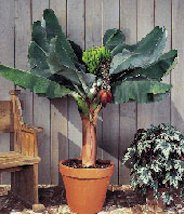
Banana flower

Green banana fruit
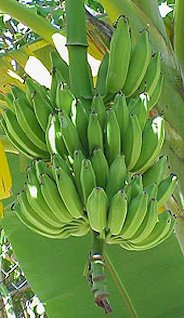
Ripe banana fruit
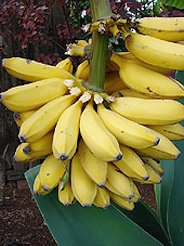
Banana pups planted up
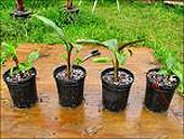
Musa 'Dwarf Red' banana
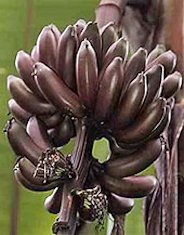
Dwarf 'Lady Finger’
 |
Conclusion
The
nice things about growing bananas indoors are that they will give your
house a great tropical feel, you will love watching them grow, and
you'll really enjoy them when it's time to eat the fruit.
Because
they are so easy to grow, even if you don't follow all the instructions
given above to a tee, but at least give your banana plant consistent
climate conditions, it will thrive for you, including producing quite a
bit of fruit.
So forget about winter weather for a while and enjoy growing a plant that will bring a bit of the tropics to your house!
|
Banana foliage
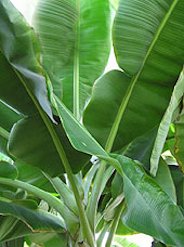
|
Hilary
Rinaldi is a member of the National Garden Writers Association, a
nationally published writer, and a certified organic grower. She
regularly speaks and writes about all gardening related topics, with an
emphasis on making gardening a successful and enjoyable process for
anyone who wants to learn. Weekend Gardener Monthly Web Magazine
concentrates of giving detailed gardening tips and gardening advice to
all levels of gardeners.
Back to
Banana Page
|
Copyright WM Media. All rights reserved.
This work is licensed under a Creative Commons Attribution-NoDerivs 2.5 License.
|

 So
often during the cold winter months people get tired of growing the
same old "house plants" and want to try something more tropical,
exotic, or unusual.
So
often during the cold winter months people get tired of growing the
same old "house plants" and want to try something more tropical,
exotic, or unusual.









